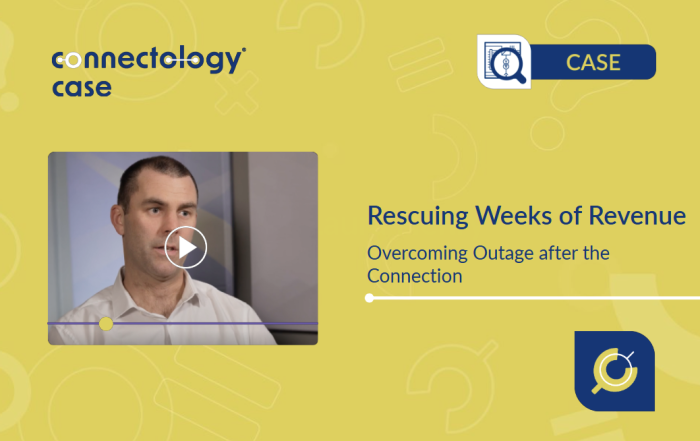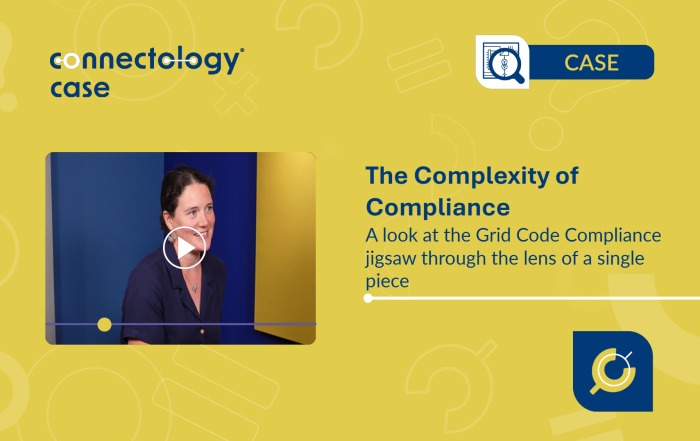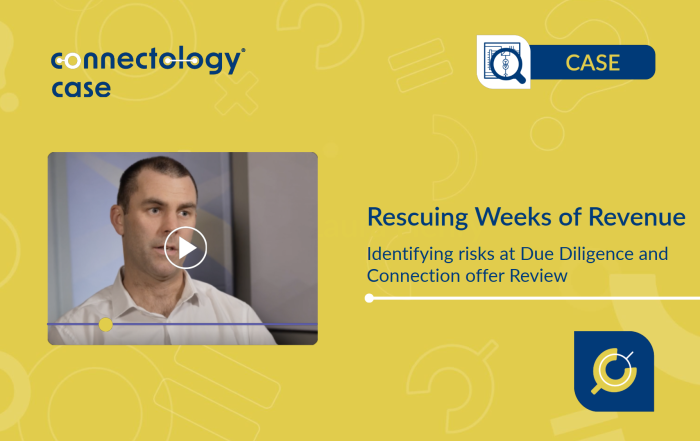
The Complexity of Compliance – a look at the grid code compliance jigsaw through the lens of a single piece
If we are a fit, you can let us handle your grid risks and complexities, so you can focus on achieving real impact.
Summary:
In this second episode of Connectology Cases, Catherine Cleary is discussing the advice she gave to one of the first directly connected tertiary winding and transmission connections for solar in the UK. Catherine discusses a complicated and innovative process that her client implemented to navigate new power system models requirements, after grid code changes in 2019.
She hopes that by unpacking one of the many challenges you can experience in the grid code compliance process, she highlights how complex the wider compliance piece can be. We understand the stress caused by network nightmares, and Catherine hopes this insight can provide insight into your own connection conundrums.
Transcript:
00:05 What is the project?
So, the project was a 50-megawatt solar farm. It was slightly unusual in that it was a direct transmission connection. So, this was one of the first directly connected tertiary winding and transmission connections for solar in the UK – I think it was actually number two.
00:20 What service did we provide?
And the service that Roadnight Taylor were providing was essentially a kind of owner’s engineer support role through the grid compliance process. Grid compliance at transmission is quite complicated in the UK so we thought it was probably quite useful to do a case study on some of the real specific challenges that projects like this face, going through a relatively kind of involved and bureaucratic clunky process. In this instance, for example, the EPC and in fact all of the contractors involved were new to this, so they’d been used to delivering 33 kV distribution connected solar farms and they weren’t used to the kind of process that National Grid, ESO require you to go through as a compliance process. It’s really important because ultimately you can’t energise the solar farm until you’ve met the key EON requirements, so energisation operational notification requirements from the ESO, and it’s sort of absolutely critical that you meet that on schedule and then that you relatively quickly meet the next operational notification milestone, which is an ion, to enable full export from the solar farm. So, until you’ve done that, until you’ve ticked all those boxes, you can’t export your power.
01:30 What was the primary challenge?
Probably, to pull out one of the many challenges that there are across that grid code compliance piece, which might sort of last for about sort of 12 to 14 months on this project so far, we found that, for example, the requirements on power system models were probably one of the most challenging areas. So, there’s been some recent changes to the grid code since August 2019, when there was quite a big grid outage on the GB transmission system that resulted from a couple of power stations got hit by a lightning strike, went offline and didn’t behave in the way that National Grid expected them to behave on the basis of their power system models. Since that, National Grid have implemented a change to the grid code and increased the requirements on power system models. They now want really detailed unencrypted RMS, so steady-state models for all power stations, and that change has been pretty pivotal to the way that generators now have to think about preparing and submitting these models as part of the grid code compliance process. In the old days, as you can see on this diagram, for something like a solar farm you would have had the inverter manufacturer provide an encrypted model and then for the power part controller, so the control system for the site would also have provided an encrypted model. Those two models could be combined fairly easily by a power systems consultant and that would be submitted to National Grid as part of their compliance process. That doesn’t work if National Grid need an unencrypted model. Unencrypted models tend to, if they’re detailed models at least tend to include quite a lot of manufacturers kind of own IP so they’re not keen to share these directly with studies, consultants or anyone other than directly with National Grid under, normally under an NDA. So, we found it was actually really challenging to be able to combine two manufacturers’ models and provide National Grid with a single unencrypted model.
03:39 Collaboration
We were working with a number of parties across this project. So, Roadnight Taylor had been supporting on the kind of overall grid code compliance process, and we worked really closely with owners, engineers, Skyray – who really kind of managed to coordinate the contractors and some of the less technical elements of the compliance process and that kind of project management piece incredibly efficiently. And then we had Blake Clough as the studies consultants. So, Blake Clough were a lifesaver really, because they were able to sort of propose some solutions to this model’s issue. It was absolutely kind of key that that we had those partnerships, I think because for the client they were effectively feeling the pain of being one of the first parties to go through this compliance process for solar at that transmission.
04:28 Our Solution
One of the solutions that Blake Clough came up with was effectively to come up with a generic copy of one of the models on an unencrypted basis, so rather than have to try and take two unencrypted models that weren’t allowed to be shared with anyone other than the ESO. The ESO refused to combine them. So rather than deal with those kinds of two NDAs which couldn’t be broken, we effectively took one of them out of the picture and Blake Clough mimicked the behaviour of the power systems controller. So, what you can see on the screen here is Blake Clough effectively producing their own generic model of the power systems controller, the PPC, and combining that with the encrypted inverter manufacturer’s model, that as an overall model is still encrypted because it still encrypts the inverter’s own IP within it, but it’s only the inverter’s IP which is now contained within that encrypted model. So, we’ve removed the kind of second element to that. Blake Clough produced that for the client, the client could then send that to the inverter manufacturers themselves and they, and only they, were able to unencrypt that model and send it directly to National Grid under their NDA. So the end result is that National Grid get an unencrypted model so that they can approve that the unencrypted model does represent the full behaviour of the solar farm, because Blake Clough have done the work to kind of validate that generic model and ultimately that was what was required for National Grid to accept and kind of tick that box in the compliance process.
06:10 Impact
It did have an impact which is quite important, which is that any alterations to the project or any alterations to the model had to repeat this entire process. So, this solution, whilst it worked, is quite onerous on the client, the end client, and we did actually have to go through this iteration loop more than twice to reflect changes to the models, as we sort of saw a little bit more about how the plant actually behaved.
The project’s still carrying on, it’s energized now and but the compliance piece of work continues so there’ll be testing that goes on on-site and there will be further work required to validate those models against the on-site tests, and so it’s going to need again additional inputs and both in terms of coordinating the contracts on site and from the past systems consultants Blake Clough.
07:02 Key Takeaways
But we thought it would be useful as a case study to kind of document where we’ve got to so far, and I think particularly for customers who are trying to deliver any kind of transmission connections, so large-scale projects at 275kV or 400kV, definitely for tertiary windings or for grid parks, for example, and I think our learning really was that kind of the need for there to be a team effort between multiple contractors. So, you know, the studies consultants being really key. So, you know Blake Clough did an amazing job on this project but needing that kind of sort of support and engagement from all parties to kind of coordinate the different contractors, so inverted contractors as part of the EPC, as well as that kind of studies piece. So ideally that kind of team effort and thinking about it as early as possible on in the project just means that you’re minimising the risk to delay. Overall, I think it probably took us about six months to get to this sort of solution, this kind of workaround. So, you don’t want to be a couple of months prior to energisation finding that out.
The client I think you know, we were really lucky, this client is one we’ve done other work with, you know we’ve built a good relationship with them, and I think they took the rough with the smooth and have sort of forged a way through this. It definitely wasn’t pain free for them, but I think the kind of learning is there and we’re just trying to spread the message now, I think that this is something that needs to be thought of really quite early on in a project. We definitely wanted to talk about this because it is only the second time, we’ve done a solar project in the UK connecting at transmission level, which has definitely kind of added the challenge. By comparison, sort of battery projects don’t tend to have this same issue because they don’t tend to have the two different manufacturers for the PPC versus the inverters – so that was really important. I think you know the fact that these grid code changes have come in relatively recently, you know, and perhaps have not been particularly well broadcast. So, I think definitely you know it’s a really good learning point to sort of understand the impact of some of those quite kind of techie or geeky grid code changes. The real project impact is quite significant, and I think just to highlight one element of what is a really complex technical process, you know. So, this is, by all means, you know, this is not the only element of grid code compliance. You know, I think even for anyone who doesn’t understand anything about models or, you know, doesn’t sort of necessarily get involved in that particular element, this gives you a flavour of the kind of complexity of the overall process of grid code compliance. And so it’s kind of it’s this across a whole number of different facets of the project and I think it’s, you know, it’s good for us to talk about projects not just once they’re done and dusted, so this is a live project and it will hopefully reach its kind of final operational notification shortly and we’ll continue to work with our partners on that, so that’s quite exciting!
Watch more of our latest Connectology® Cases
Polly Stevenson2025-04-15T12:15:15+00:00
Polly Stevenson2025-04-15T12:17:24+00:00
Polly Stevenson2025-04-15T12:18:04+00:00




